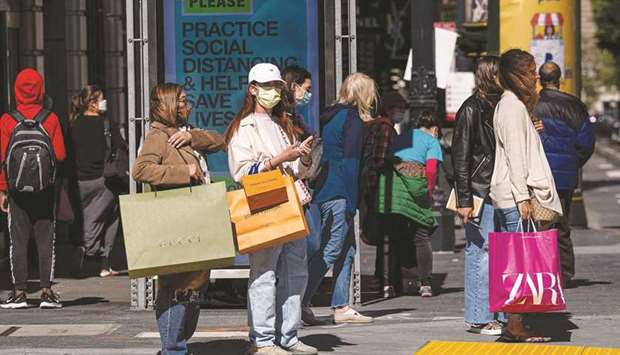US consumer spending rose more than expected in June as vaccinations against Covid-19 boosted demand for travel-related services, but part of the increase reflected higher prices, with annual inflation accelerating further above the Federal Reserve’s 2% target.
Though personal income barely rose last month, other data on Friday showed wage growth in the second quarter was the fastest in 13 years on an annual basis.
That, together with rising household wealth and ample savings should keep consumer spending strong, though rising Covid-19 infections pose a risk.
“The overall trend of healthy-to-strong growth will continue into next year,” said Scott Hoyt, a senior director at Moody’s Analytics in West Chester, Pennsylvania. “Downside risks remain large.
The return of shutdowns from increased infections is unlikely, but cannot be ruled out.
There are also upside risks, especially given all the extra saving that has taken place since the spring of 2020.”
Consumer spending, which accounts for more than two-thirds of US economic activity, rebounded 1.0% last month after dipping 0.1% in May, the Commerce Department said.
Nearly half of the population has been vaccinated against Covid-19, allowing Americans to travel, frequent restaurants, visit casinos and attend sporting events among services-related activities that were curbed early in the pandemic.
Spending on services advanced 1.2% last month after rising 1.0% in May.
The broad increase was led by spending at restaurants and hotels.
While spending on goods remains strong, the pace has slowed amid shortages of motor vehicles and some household appliances, whose production has been hampered by tight supplies of semiconductors across the globe.
Spending on goods rose 0.5% after dropping 2.1% in the prior month.
Spending on long-lasting goods decreased 1.5%, reflecting a decline in motor vehicle purchases.
Outlays on nondurable goods rose 1.8%. The data was included in the second-quarter gross domestic product report published on Thursday.
Consumer spending grew at a robust 11.8% annualised rate last quarter, accounting for much of the economy’s 6.5% growth pace, which lifted the level of GDP above its peak in the fourth quarter of 2019. With demand outpacing supply, inflation is rising.
The personal consumption expenditures (PCE) price index, excluding the volatile food and energy components, rose 0.4% in June after advancing 0.5% in May.
In the 12 months through June, the so-called core PCE price index shot up 3.5%, the largest gain since December 1991.
The core PCE price index increased 3.4% year-on-year in May.
Economists polled by Reuters had forecast consumer spending increasing 0.7% and the core PCE price index surging 3.7% year-on-year.
The core PCE price index is the Federal Reserve’s preferred inflation measure for its flexible 2% target. US stocks opened lower. The dollar fell against a basket of currencies.
US Treasury prices were higher.
The US central bank on Wednesday kept its overnight benchmark interest rate near zero and left its bond-buying programme unchanged.
Fed Chair Jerome Powell, who has attributed the high inflation to supply constraints as the economy reopens, told reporters that “these bottleneck effects have been larger than anticipated, but as these transitory supply effects abate, inflation is expected to drop back toward our longer-run goal.”Excluding inflation, consumer spending rebounded 0.5% in June after dropping 0.6% in May.
The bounce back in the so-called real consumer spending last month puts consumer spending on a higher growth trajectory heading into the third quarter.
Personal income gained 0.1% in June after dropping 2.2% in May as transfers from the government declined.
The saving rate dropped to a still-high 9.4% from 10.3% in May.
Though the fiscal boost is fading and Covid-19 cases are rising in states with lower vaccination rates, driven by the Delta variant of the coronavirus, consumer spending will likely continue to grow.
Households accumulated at least $2tn in excess savings during the pandemic.
Record-high stock market prices and accelerating home prices are boosting household wealth.
Wages are also rising as companies compete for scarce workers.
In a separate report on Friday, the Labor Department said its Employment Cost Index, the broadest measure of labour costs, rose 0.7% last quarter after gaining 0.9% in the January-March period.

People wearing protective masks carry shopping bags while waiting to cross Geary Street in San Francisco. US consumer spending rose more than expected in June as vaccinations against Covid-19 boosted demand for travel-related services, but part of the increase reflected higher prices, with annual inflation accelerating further above the Federal Reserve’s 2% target.


